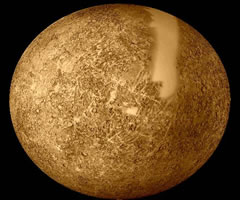
- World Cience -
:..Piters M. Olivera - Webdesigner..:
clasificados
 |
Mercury, named for the Greek and Roman winged messenger of the gods, is the closest planet to our Sun. Mercury probably got its name because of the way it appears to travel so quickly through the sky. Mercury is difficult to see with the naked eye at certain times of day because of its proximity to the Sun. However, even the ancient Egyptians knew about the planet. |
Mercury has a very eccentric (elliptical, as opposed to perfectly round) orbit, so it is closer to the Sun at certain times than others. This results in a huge variation in temperature throughout the year. The high and low temperatures on Mercury are six hundred degrees apart! This huge swing in temperature is the largest for any of our solar system's nine planets. ATMOSPHERE AND MAGNETIC FIELD Mercury also has almost no atmosphere. Its most abundant gas is helium, which probably originates from the radioactive decay of uranium and other elements on the surface. All the heat from the Sun causes this radioactivity. Mercury does have a magnetic field, but it is not as strong as Earth's. The field comes from the planet's large iron core, but Mercury's slow rotation keeps the field weak. SURFACE The surface of Mercury looks a lot like the Moon's surface because of its craters. One feature which makes Mercury unique is a huge crater called the Caloris Basin. Some large object must have collided with Mercury many years ago to create the basin, which is 1,300 km in diameter. Whatever that object was, it can also take credit for causing mountain formations and geological features on Mercury's surface. There are also a number of volcanoes on Mercury's surface, which helped to make the surface the shape it is now. MOONS Mercury is too small and too close to the Sun to have any moons. In fact, the closest planet to the Sun that does have moons is Earth.
|
|